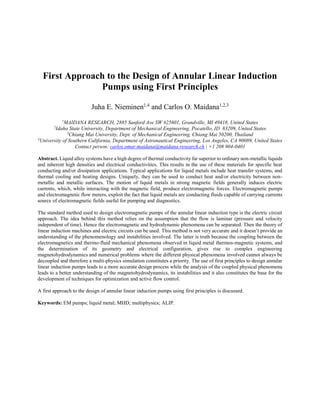NETS_2016_Abstract_Maidana_02
- 1. First Approach to the Design of Annular Linear Induction Pumps using First Principles Juha E. Nieminen1,4 and Carlos O. Maidana1,2,3 1 MAIDANA RESEARCH, 2885 Sanford Ave SW #25601, Grandville, MI 49418, United States 2 Idaho State University, Department of Mechanical Engineering, Pocatello, ID 83209, United States 3 Chiang Mai University, Dept. of Mechanical Engineering, Chiang Mai 50200, Thailand 4 University of Southern California, Department of Astronautical Engineering, Los Angeles, CA 90089, United States Contact person: carlos.omar.maidana@maidana-research.ch | +1 208 904-0401 Abstract. Liquid alloy systems have a high degree of thermal conductivity far superior to ordinary non-metallic liquids and inherent high densities and electrical conductivities. This results in the use of these materials for specific heat conducting and/or dissipation applications. Typical applications for liquid metals include heat transfer systems, and thermal cooling and heating designs. Uniquely, they can be used to conduct heat and/or electricity between non- metallic and metallic surfaces. The motion of liquid metals in strong magnetic fields generally induces electric currents, which, while interacting with the magnetic field, produce electromagnetic forces. Electromagnetic pumps and electromagnetic flow meters, exploit the fact that liquid metals are conducting fluids capable of carrying currents source of electromagnetic fields useful for pumping and diagnostics. The standard method used to design electromagnetic pumps of the annular linear induction type is the electric circuit approach. The idea behind this method relies on the assumption that the flow is laminar (pressure and velocity independent of time). Hence the electromagnetic and hydrodynamic phenomena can be separated. Then the theory of linear induction machines and electric circuits can be used. This method is not very accurate and it doesn’t provide an understanding of the phenomenology and instabilities involved. The latter is truth because the coupling between the electromagnetics and thermo-fluid mechanical phenomena observed in liquid metal thermos-magnetic systems, and the determination of its geometry and electrical configuration, gives rise to complex engineering magnetohydrodynamics and numerical problems where the different physical phenomena involved cannot always be decoupled and therefore a multi-physics simulation constitutes a priority. The use of first principles to design annular linear induction pumps leads to a more accurate design process while the analysis of the coupled physical phenomena leads to a better understanding of the magnetohydrodynamics, its instabilities and it also constitutes the base for the development of techniques for optimization and active flow control. A first approach to the design of annular linear induction pumps using first principles is discussed. Keywords: EM pumps; liquid metal; MHD; multiphysics; ALIP.

